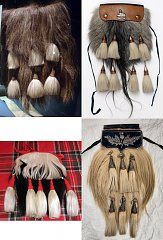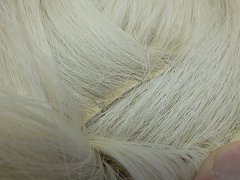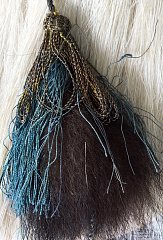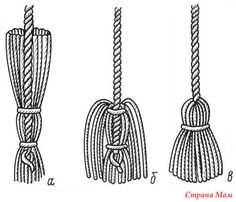|
-
26th November 23, 12:34 PM
#1
18th/19th Century Sporran Tassel Construction
Hello All,
Can anyone advise on construction techniques of late 18th/early 19th horsehair tassels
for regimental/civilian sporrans? I'm thinking specifically of the 97th Regiment sporran
owned by the NMS, but am curious about anything from that period. Specifically, how
is the horsehair bundled, and then attached to the cord, and the leather sleeve applied?
It seems like it would be a simple matter, but maybe not, being unable to view how everything
is run together.
Any help appreciated!
Cheers,
Alex
-
The Following User Says 'Aye' to myrmiddon For This Useful Post:
-
26th November 23, 08:14 PM
#2
Alex,
I don't know the answer per se but the style of the 97nd one is similar to Lt Bramwell's 92nd one from 1814, albeit that that one has outer metal cones over the leather. Similar to to two civilian ones from about the same time. There's nothing like being able to example an original, None of these are immediately accessible but the bottom right belongs to the Scottish Tartans Authority which I can get access to once the V&A Tartan exhibition is over in January.

There are a couple of collectors in Scotland who might know the answer, I've discussed with one and we've both come to the conclusion that neither knows the answer. From looking at some from the early Victorian era it seems that what went on under the bell was a bit random and not always that tidy. Out of sight, out of mind.
Last edited by figheadair; 27th November 23 at 03:17 AM.
Reason: More info
-
The Following User Says 'Aye' to figheadair For This Useful Post:
-
27th November 23, 08:12 AM
#3
Hello Figheadair,
Amazing what a puzzle the smallest of seeming little details are when you think about them, eh? I appreciate your looking into this for me, and any help would be most gratefully received. The answer is probably simple, but until you know, you don't really know. Many thanks ahead of time!
Cheers,
Alex
-
-
28th November 23, 04:11 AM
#4
Do these pictures help..?
It is a London Scottish OR sporran from the 1914-18 war era, and the construction appears to be the same as that on a c1890 of the same style that I have, and also of those of mid-20th century hair sporrans.
There must be a limited number of options for tasselling horse-hair, so the desired effect and result will have been decided upon fairly early in their use, and what my picture shows is likely to have been a well-established method by the mid-19th century.
The technique appears to be to take a length of hair of the desired quantity, and fold it over a thin cord or thread at the middle point of the hair. The ends of the cord are wound around the hair tightly at the top of the tassel, and then again lightly further down, and tied-off. This portion is covered by the cone.
The cone itself adds a form of compression to the top of the tassel, that encourages the hair lower down to spread slightly and so give the characteristic appearance.
The tip of the tassel is attached to the suspension chain (or whatever might be used) by a few stitches of thread through the last link. I have also seen wire used for attaching the chain, both as the original methed and as a repair.
My assumption has always bee that the sporran-maker used whatever method he found most convenient and expedient at the time - which was not always the best, strongest or most durable.
The hair on the body of the sporran is now mostly strands of hair folded over a cord and tied in place, to form a long strand of fringing. This cord is then attached to the body of the sporran in a zig-zag way so that the danging hair covers the cords of the lower levels. This is often done over a sheepskin or similar under-layer to give the hanging hair a bit more bulk.
I recently had the chance to examine and study in detail two horse-hair sporrans that are known to date from c1840, which use a totally different technique. These use the pelt taken from around the base of the horse's tail with all the hair still attached to the skin. The skin has been attached to the sporran using a series of sewn-down pleats and folds which give a fair amount of bulk, but these have no tassels. See pics.
 
Last edited by Troglodyte; 28th November 23 at 04:12 AM.
-
-
28th November 23, 04:15 AM
#5
Previous picture up-load failed.
So try again. Tassel construction on LS sporran.

-
-
28th November 23, 05:43 AM
#6
 Originally Posted by Troglodyte

Previous picture up-load failed.
So try again. Tassel construction on LS sporran.

Very useful, thanks.
Here's another technique, one which I don't pretend to understand fully. It is from a c.1815 sporran in which there are no bells on the tassels but I assume the same technique could have been used and a wide/round top bell added.
This one has three layers: hair; fine cord; and fine metal thread, all formed over a bead of some sort which was presumably attached to the chain first.

-
-
28th November 23, 06:16 AM
#7
 Originally Posted by figheadair

Very useful, thanks.
Here's another technique, one which I don't pretend to understand fully. It is from a c.1815 sporran in which there are no bells on the tassels but I assume the same technique could have been used and a wide/round top bell added.
This one has three layers: hair; fine cord; and fine metal thread, all formed over a bead of some sort which was presumably attached to the chain first.

I suspect the tassel has been made in the way shown in the attached picture - the hair tied onto a cord, folded over and tied again to give it form and bulk.
If I were making the tassel in your picture, I would place the fancy thread around the other so that it formed the outer layer when turned and tied for the second time.
If the cord the tassel is tied to is given a knot for the folded-over hair to form around, more bulk and shape could be achieved. Think of the fancy results haberdasher get with their soft-furnishing tassel trims and curtain-ties...

-
The Following 2 Users say 'Aye' to Troglodyte For This Useful Post:
-
30th November 23, 06:45 AM
#8
-
-
30th November 23, 06:55 AM
#9
About the horsehair body itself, I posted some photos of how the hair is attached on a c1967-c2000 MOD Other Ranks sporran on this thread
https://www.xmarksthescot.com/forum/...ch-hair-97321/
Proud Mountaineer from the Highlands of West Virginia; son of the Revolution and Civil War; first Europeans on the Guyandotte
-
-
30th November 23, 10:38 AM
#10
Hello All,
Apologies for responding so late-- was having problems replying and getting error codes.
Thanks to all who have replied! There are some really good posts here, which I think have
solved the mystery of how to make a period tassel. I would never have guessed to fold the
horsehair over a ring or knot. Absolute genius.
Cheers!
Alex
-
 Posting Permissions
Posting Permissions
- You may not post new threads
- You may not post replies
- You may not post attachments
- You may not edit your posts
-
Forum Rules
|
|




















Bookmarks